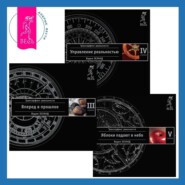По всем вопросам обращайтесь на: info@litportal.ru
(©) 2003-2025.
✖
Tufti the Priestess. Live Stroll Through a Movie
Настройки чтения
Размер шрифта
Высота строк
Поля
You become a responsible, sane character who can freely roam around in the dream. You have already tried it in waking life. With time, you will learn to do the same in your sleep.
However, it is much more important to have this ability in waking life because even though the film of sleep has a real film roll in the Eternity archive, it is still virtual. Life, on the other hand, is real. In life, you either helplessly kick your legs about in someone else’s script or you implement your own.
The only thing stopping you from doing this is your habit of falling into the inner and outer screen. Your attention won’t stay long in the centre of awareness. This is quite normal for you. But what can you do, ugly fit-for-nothings that you are. You need to develop the new habit of returning your attention to the centre.
Setting out for a stroll through the dream, tell yourself that you won’t forget that you must wake up. Literally set yourself this goal, otherwise it will completely slip your mind that you are meant to be focusing on something. If you are lazy and forgetful, you won’t learn anything.
Whilst on your walk, you will need to catch yourself as you constantly fall and drift off. Don’t worry, don’t give up, just bring your attention back, over and over again. Arrange to track your attention with your attention itself – that is, yourself.
There is no need to try and hold your attention at the centre all the time without taking a break. The meaning and value of this exercise lie in something else: your ability to respond to what is happening. Usually, any event, even the most inconsequential, draws you into the outer film or into your inner concerns. Whatever the situation, it lulls you into sleep.
Now you need to develop the reverse habit – not to fall asleep but to wake up. Any event, even the slightest whiff of your environment should put you on your guard. Take it as a signal to awaken. Likewise, any action you take should remind you that you need to check your focus of attention.
You have two triggers for this.
Outer – as soon as something happens, you wake up.
And inner – before you do something, you wake up.
Examples of external triggers: you met with someone, someone asked you something, something happened close to you, it doesn’t matter what, some kind of sound, any kind of movement, anything that previously attracted and engaged you. As soon as something happens, focus your attention on it, but don’t lose control of your attention – keep it at the centre.
Examples of internal triggers: you’re getting ready to go somewhere, to do something, to talk to someone. Before you take any action at all, bring your attention to the centre. Specifically before, because afterwards it will be too late; you will simply discover that you fell asleep, then woke up to remember that you were sleeping.
All this can only be learned through frequent repetition like in the martial arts. There is no other way. On the other hand, when you learn to control the focus of your attention, you will be able to control your piffling life. And then, perhaps, your life will stop being so piffling.
For now, I give you a warning. You have woken up in a dream, acquired strength and awareness, while those around you continue to sleep. Do not think this advantage makes you superior. Don’t treat others with arrogance or condescension. This prerogative belongs solely to me because I am Tufti, your priestess, and you are my subjects who must listen to me – and admire me unstintingly. Do you? Look at me!
Composing Reality
So, my dear pretties, you now have a greater understanding and have learned something. See, I praise you too! In our last lesson, we studied how to track attention.
• Set yourself the goal of remembering to track your attention.
• As soon as something happens, you wake up.
• Before doing anything, you wake up again.
If you do this, you will develop the habit of controlling your attention, and eventually, your life. But this does not give you the right to look down on those who are asleep. Observe them quietly without giving away that you know something they don’t. Pretend that you are also asleep. This goes for all walks, both in waking and in sleeping.
Remember: before entering the dream, you should be well-disposed towards others, otherwise you will be punished. A superior, arrogant, disdainful, insolent, pompous, stuck up, finicky, smart Alec know-all will get a clip round the ear. Not from me but from reality. Don’t expect such an honoured privilege from me.
Now listen. At our first meeting I said this phrase: Reality is what has never been and never will be, and only is in the here and now. Reality exists only for a single moment like a frame on a film roll, which moves from the past into the future. What are we meant to understand by this?
This means that in any moment, only the immediate impression of reality – the illuminated frame – is ever real. Everything else is virtual, the past as well as the future. And it is all stored forever in a film archive, where everything is recorded, everything that has been, that will be, and ever may be.
The past and the future are both information. Information is intangible. You can’t touch it, but the media that carries the information is material and can be opened. This is how clairvoyants look into the past and tell the future.
The film archive truly exists, although it is intangible, like the ether. Ether substance hangs in the dream space. Both in sleeping and in waking reality, the dream space is whole. In your sleep, what you see is what could be, either past or future. But whether it happened or will happen is not a foregone conclusion as the variants are infinite in number.
What might happen in a dream could also take place in waking reality, and vice versa. In this sense, the dream space is a single film archive. You can watch it and you can exist within it, both in a dream and in waking, but you only actually exist in each frame once. Each subsequent frame is a new realisation, an upgrade of everything living and non-living, right down to the level of the atom.
Only the souls of living beings remain unchanged — they are capable of watching the films of dreams and moving along the film roll of reality, together with the frame. So your Self is the same as it was in the past, as when it flew about in your dream when you were asleep, and as it will be in the future.
Our world exists in animate and inanimate form. Life is embedded like inclusions in a material reality. Reality is an inanimate substance. Life is animate and life can influence the course of reality. Life can compose reality.
The last point, my little mites, is the most important thing you need to understand. To compose reality means to choose the film roll and determine the direction in which the frame is moving. You have this opportunity, but you don’t use it, just as you fail to use your capacity for directing the focus of your attention.
You have to compose reality ahead of time, instead of fighting the current circumstances of your life. But what do you do? You try and change your reality within the current frame. Do you understand what you are doing?
Again: what is the actuality of life? It is that which has never been and never will be, and is here and now. The actuality of life only exists to the extent that it has already occurred. You cannot change what has already happened. But that is what you are trying to do because everything that surrounds you is that which has already happened.
The present differs very little from the past. The past is long gone and the present exists only for a brief moment, so you can’t change that either. Whilst you are in the present moment, you are, in effect, continually in the past because your attention is enmeshed in the current frame. The illusion grabs hold of you and keeps you from entering the future, which is why the future isn’t up to you.
You might think that you are conscious of what you are doing, that you are taking decisive action, solving problems, and achieving your goals. But all this is happening in the current frame in a non-conscious state, and so, the script carries you along a film roll that you did not choose. All you are doing, really, is helplessly twitching your paws.
That’s who you are, my sweets, my pumpkins. It’s exhausting being with you!
The Intention Plait
As always, my precious ones, we will recap what we did last time.
• The actuality of life is that, which has already occurred.
• You cannot change what has already happened. And nonetheless
• You try and change your given reality in the current frame.
• Which is why the future does not depend on you. What do you need to do?
• Setting reality ahead of time, instead of fighting the actuality of your current life.
Much of this will sound quirky to you, as for the first time, you come across a reality that is unfamiliar and strange. It’s still all the same – your reality, to which you are accustomed, but somehow different, baffing, right? Listen to what I’m saying, and don’t bother me with questions.
Why the film roll archive exists, and who shot the films to capture them for eternity, is not given to snotty pookies like yourselves to understand. Be grateful to the High Creator, that you are allowed to move with the frame for that is quite something. But you are seriously slacking in your development. You’re not even using what you already have.
Let me remind you what it means to move with the frame. As you know, the past cannot be changed. Forget about the present too. It has already occurred and is of no interest to you. On the other hand, you have the opportunity to compose the future, to choose the film roll, along which the next frame will move. How?
You have two control functions: attention and intention. We have already dealt with attention. This accounts for your state of awareness. Intention accounts for your actions. In order to undertake something, you must first take into your head the idea of it. When you actually come to execute your conceived idea, your intention is realised through action.
However, all your actions pertain to the current frame and are realised there because your intention is wedged inside it. It is just the same as when your attention gets glued to one of the screens. And just as attention has two screens, there are two intention centres: inner and outer.
The inner centre is responsible for all of your basic functionality and is located in the frontal part of the skull. This is your petty intention. When you concentrate, you wrinkle your forehead. When you intend to do something, you tense your muscles. Your muscles allow you to carry out primitive activities in the current frame.
The outer centre you totally neglect to make use of, even though it accounts for the movement of the future frame. You can determine instantly where the outer centre is located, right now.
Every single one of you has an intention plait. It is an energy plexus, similar to an ordinary plait. You can’t see it, but you can feel it like a phantom limb, which used to be there but is not anymore. Rather than hanging straight down, it sticks out at an angle to the spine. It’s a really funny kind of plait.
The outer intention centre is at the tip of the plait. It is a spot between the shoulders, only not flat to the spine, but a little away from it. You will find the precise spot intuitively. The exact distance is of no significance. It is enough to focus your attention on it, and you will feel where it is. If you can’t feel it yet, read the chapter “Plait With Flow” and then you will get it.

















